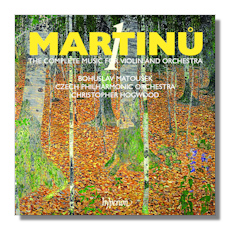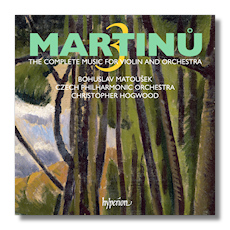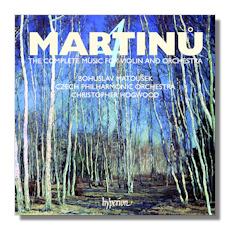
The Internet's Premier Classical Music Source
Related Links
- Martinů Reviews
- Latest Reviews
- More Reviews
-
By Composer
-
Collections
DVD & Blu-ray
Books
Concert Reviews
Articles/Interviews
Software
Audio
Search Amazon
Recommended Links
Site News
 CD Review
CD Review
Bohuslav Martinů

Complete Works for Violin and Orchestra
Volume 1
- Concerto for Flute, Violin & Orchestra, H. 252 [1936]
- Duo Concertante for 2 Violins & Orchestra, H. 264 [1937]
- Concerto in D Major for 2 Violins & Orchestra, H. 329 [1950]
Bohuslav Matoušek, Régis Pasquier & Jennifer Koh, violins
Janne Thomsen, flute
Czech Philharmonic Orchestra/Christopher Hogwood
Hyperion CDA67671 55'06 Rec. 2004, 2005


Volume 2
- Concerto da camera, H. 285 [1941]
- Concerto for Violin, Piano & Orchestra, H. 342 [1953]
- Czech Rhapsody, H. 307A [1945]
Bohuslav Matoušek, violin
Karel Košárek, piano
Czech Philharmonic Orchestra/Christopher Hogwood
Hyperion CDA67672 64'35 DDD


Volume 3
- Suite concertante for Violin & Orchestra (1st ver.), H. 276 [1939]
- Suite concertante for Violin & Orchestra (2nd ver.), H. 276A [1943-1944?]
- Rhapsody-Concerto for Viola & Orchestra, H. 337 [1952]
Bohuslav Matoušek, violin/viola
Czech Philharmonic Orchestra/Christopher Hogwood
Hyperion CDA67673 68:49 DDD


Volume 4
- Violin Concerto #1, H. 226 (H 228/233) [1931+]
- Violin Concerto #2, H. 293 [1943]
Bohuslav Matoušek, violin
Czech Philharmonic Orchestra/Christopher Hogwood
Hyperion CDA67673 DDD 54:10 2008 Rec. 2001, 2004
This is a very welcome and significant recording project and we can be grateful to Hyperion and the performing arists who have recently made it happen. These eleven works were excellently performed and recorded between 2001 and 2005 in the same venue: Dvořák Hall in Prague's Rudolfinum. Apart from its completeness aspect, most of these works are not well known and, for various reasons, some of them had very delayed premières, second performances or publications, independently of their merits – more usually from reasons to do with the soloists who commissioned them. Their stylistic differences also had a great deal to do with the individual performance styles and tastes of the commissioning soloists. In his youth Martinů was a violinist and studied with Suk in Prague and Roussel in Paris, but the works recorded here were all composed in the years of Martinů's maturity between 1931 and 1953. The ones from the 1930s tended to be in a neo-baroque concerto grosso style and the later ones tended more to neo-romanticism. Because of the Nazi occupation of France and later the communist takeover of his native country, Martinů spent much time in the U.S. where he became a citizen, taught at Princeton for a time, and received a considerable number of commissions and performances. During the Second World War he may have been the most performed classical composer in America. He also lived in Italy, France and Switzerland during his last years.
If I may venture a generalization about the mood and character of these works in general, they tend to have a vigorous forward motion, especially as performed here, and might even be said often to express joy and rarely any negative feelings. And if I may mention a recurring detail, which always says Martinů to me, I have been much struck by Martinů's occasional but striking use of a characteristic musical gesture – almost a signature of his – in these and other works: it has varied specifics but evokes an almost visual image; it begins with a vigorous thrusting long note followed by a short one or two and then a vigorous long one again, higher or lower than the first.
I shall discuss these works in the order in which Hyperion has elected to present them.
The rather short Concerto for Flute, Violin and Orchestra includes also an important part for piano. The opening allegro moderato is vigorous and some of it is fast, but there is also flowing melody and the solo violin is sweet sounding. The adagio opens gently with sounds of the piano and flute and ends gently with the flute emphasized again. The movement is lyrical and melodious but contains enough tension to sustain interest; there is a particularly intense passage toward the end. The final poco allegretto is exciting.
The Duo Concertante, composed a year later and also rather short, alternates solos and tutto and begins with an intense but upbeat poco allegro. The adagio opens with high notes for the violins succeeded by massed strings. Accompaniment here by drums and piano is intense, though not distressed sounding. Pleasantly melodic playing with a few fluttery sounds, a relaxed mood and a harmonious ending follow. The final poco allegro has a very vigorous opening with sounds of a piano. To my ears the allegro is not so "poco" but the pace is not forced. A couple of minutes in soft trumpet playing is heard, again with the piano. Crisp, staccato playing builds momentum to a joyous abandon. The concluding Allegro has an almost raucous opening, again with the piano, vigorous rhythms, and virtuoso writing.
Concerto in D Major for Two Violins is a late work, written for a large orchestra in the romantic tradition. It was commissioned by twin virtuoso violinists, who held onto the performing rights so long that the work was published only after the composer's death. There were also problems with publishers. The work was rediscovered decades later. In this performance at least, the opening poco allegro is more than a little fast, cheerful, and very vigorous. The commissioning soloists presumably will have enjoyed playing the double, triple and quadruple (!) stops, which gave the effect of a string quartet. The second movement has a rather perky opening and accented rhythms, light and bouncy at one point, but reflective elsewhere and there is some sweet melody The final, Allegro con brio, movement follows without pause and is upbeat and lively. The cadenza for duo violins is notably effective.
The Concerto da Camera was commissioned by Paul Sacher and dedicated to him and the Basel Chamber Orchestra. For it Sacher had in mind a violinist whose strengths were "tremendous technique," vigorous momentum rather than elegance but also soft playing with "intimate charm," as he described her. Martinů produced a work in concerto grosso form, for a string orchestra plus piano and percussion in addition to the solo violin. The first movement, Moderato is more vigorous than moderate and has driving rhythms, but I would not call the performance "driven." The Adagio is songlike and the booklet commentator, Ales Brezina, compares it to a baroque aria and it is densely polyphonic. The pace is slow – definitely adagio. It is quite nice. There is a regular rhythmic accompaniment. The finale is a rondo, lively and bouncy, but with a notable ritard followed by quiet playing for violin and piano before the pace picks up at the conclusion. Brezina says that it is because of the work's "freshness of its musical invention, the sensual sound of the orchestral part and the virtuosity of the solo parts," that this work is a favorite among Martinů's concertos.
The Concerto for Violin, Piano and Orchestra is a late work and its emotional tone may reflect Martinů's personal issues at the time of composition. It is quite tonal but there are some jazz elements and a toccata-like opening; the commentator refers to a "feverish ostinato." Perhaps incongruously there is also a "Dvořák-like melody" in the strings. For what it might be worth, Brezina compares this concerto to Martinů's 4th Symphony and thinks that the mood reflects the memory of war. The adagio is quite beautiful. The opening is hushed and the pace almost stately but later there is some of the loudest playing in any of these pieces. The finale is very vigorous and the opening even rather wild. There are irregular rhythms accentuated by the trumpet. There is also a nice dialogue between the two solo instruments.
The Czech Rhapsody was commissioned by Fritz Kreisler but he never played it, perhaps because it exceptionally difficult technically and he was seventy years old at the time. The orchestration was commissioned by the Martinů Foundation because, although the composer wrote only a piano reduction of what he evidently intended to orchestrate, he did not get to it. It is quite a nice piece. It has irregular rhythms but also some sweet passages, especially for the violin solo. Mostly lively, it ends with a satisfying thump.
The two suites concertante were commissioned in 1938 by the violinist Samuel Dushkin, who is also known for inspiring Stravinsky's violin concerto. Partly because of the world war, and partly because of an erroneous impression that Dushkin and Martinů were dissatisfied with it, the first performance with orchestra did not occur for more than fifty years. To be sure, Dushkin prefered the second version, which is different enough from the first to be quite a different work. The movements of the first version were entitled Prelude, Meditation (originally Elegy), Intermezzo and Finale. These became a Toccata, Aria, Scherzo and Rondo. The first suite is in virtuoso style except for the slow Meditation; the Intermezzo also has some slow, lyrical passages in addition to some lively staccato playing. The Toccata opening of the second version begins as one might expect from the name, with staccato playing from both soloist and the full orchestra including brass. The second movement opens with only strings playing and only the orchestra is heard for the first couple of minutes. The Scherzo is lively and playful, with interesting solo/orchestral interaction. The Rondo begins with a strong orchestral statement, becomes quiet and then lively.
The Rhapsody-Concerto for Viola and orchestra is neo-romantic and one of the most played viola concertos from the last century. It has only two movements. The first, Moderato, begins gently with flowing melody and the viola enters quietly. The movement is mainly calm and lyrical, though there is some lively motion and there are drums and trumpets before the tranquil and beautiful ending, with the viola having the last word. I noted a slow, gentle crescendo and some swelling sound. Some nice parts for the winds include a flute solo against a light accompaniment. The second movement, Molto adagio – Poco allegro – Andante molto tranquillo, includes some brass in the fast part. The viola is allowed to be heard well over the accompaniment and its sonority during the cadenza is particularly satisfying.
The two concertos for solo violin and orchestra particularly illustrate what I said at the outset about the importance of the commissioner to the character of the work. For Dushkin, who commissioned the first, in addition to the suites, virtuosity was paramount. In consequence, the opening and closing movements (including triple stops) are what I would call flashy and not at all to my taste. I do like the Andante, the pace of which is on the brisk side. This composition caused Martinů a great deal of trouble, as did the first suite. In the case of the latter, Martinů threw out the first three movements he wrote; in the case of the concerto, he completed writing it in two months, but then Dushkin insisted on revision after revision, such that its première was delayed until 1973, long after Martinů was gone. The story of the commission of the very different second concerto is amazing but evidently well documented. Mischa Elman, the world renowned soloist known mainly for performing 18th and 19th century music, happened to hear Martinů's first symphony in Carnegie Hall in 1944 and was so impressed that he visited Martinů to offer a commission. Martinů had never heard any of Elman's playing, nor that of any of the other leading violinists of the time and frankly said so. He did however agree to listen to Elman play. After hearing Elman for a half hour or so, Martinů remained silent and went away, only to surprise Elman two months later with the complete score of the second violin concerto. The really amazing thing is that he tailored the solo part to Elman's taste and style of playing, his kind of sound, his love of slow tempos, his use of portamento and rubato and a preference for "noble and elegant melodies." Actually, the opening bar of the work is quite harsh sounding and in the first movement the orchestra punctuates the sweet sounding solo violin with some harsh chords. Some of the orchestration is quite interesting. The Andante is fresh and interesting. The pace has forward motion and euphonious sounds are succeeded by intense as well as gentle passages. The finale begins with a crash and loud vigorous sound from the orchestra is guaranteed to hold the listener's attention. Some passages for the soloist dominate the orchestra and are vigorous without being flashy. There is some particularly striking melodic cooperation between the solo instrument and the orchestra at one point. The conclusion features some lively, skipping syncopation.
I strongly recommend these recordings. If pressed to say which to try first, I would say to acquire them in the order they were released but this is probably just reflective of my own tastes.
Copyright © 2009, R. James Tobin




















